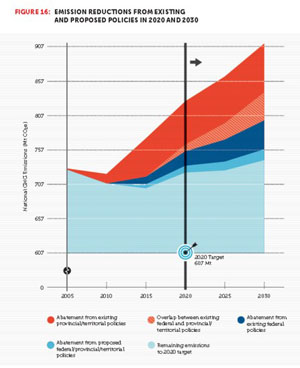Reality Check: The State of Climate Progress in Canada
 Despite making progress in reducing greenhouse gas emissions, Canada is not on track to achieve the federal government’s 2020 reduction target of 17% below 2005 levels, concludes a new report by the National Round Table on the Environment and the Economy.
Despite making progress in reducing greenhouse gas emissions, Canada is not on track to achieve the federal government’s 2020 reduction target of 17% below 2005 levels, concludes a new report by the National Round Table on the Environment and the Economy.“Canada will not achieve its 2020 GHG emission reductions target unless significant new, additional measures are taken. More will have to be done. No other conclusion is possible”, states the NRT report.
Reality Check: The State of Climate Progress in Canada was undertaken last year at the request of the federal Minister of the Environment to inform the government’s regulatory approach to reducing emissions. NRT’s research is based on original modelling using Environment Canada’s data as a principal source, as well as extensive consultations with the provinces and territories, academic and public policy experts.
The report serves as a reality check on the state of climate progress in Canada today. It reinforces some key truths about climate policy in Canada: that a national target needs a concerted national policy behind it, that policy uncertainty still exists and stifles progress, that the country has yet to implement effective policies to address some large sources of emissions, and that all this means progress has been and will remain difficult and uneven across the country.
Assessing the Gap
The report shows that Canada is making significant progress toward its 2020 target but will not get there with only existing and proposed climate policy measures by all governments. More precisely, the NRT found that:
•Combining all existing and proposed federal, provincial and territorial climate policies and actions would lead to a reduction of 104 Mt CO2e in 2020, which represents almost 50% of the required emission reductions to meet Canada’s target of 607 Mt CO2e in 2020 - but an emissions gap of 117 Mt CO2e remains.
•Provincial policies are driving the largest portion of emission reductions to date - 75% of all emission reductions by 2020 - although the federal portion should rise to approximately a third by 2030.
•Provinces are making progress toward achieving their own targets, but almost all will need to introduce additional measures to meet them. Only Nova Scotia, and possibly Saskatchewan, are forecasted to achieve their targets.
Closing the Gap
According to NRT President and CEO, David McLaughlin, time is short on taking steps to bring about the necessary emission reduction and that as time goes on, the more difficult and expensive it will be for Canada to meets its objectives.
“Our analysis could not be clearer: Canada cannot cherry-pick its way to 2020”, he said. “This will require a more engaged and integrated climate change policy approach at the pan-Canadian level than what we have seen to date”.
In the report the NRT notes that while the target is not yet out of reach, the cost of additional policies to close the gap will be higher on average than policies pursued to date.
 The report shows that while almost half the emission reductions to date from existing and proposed measures have been in the low-cost range of $50 per tonne and under, achieving Canada’s 2020 target in the most cost-effective way will require an increasing share of emission reductions to come from medium and high cost measures of up to $150 per tonne.
The report shows that while almost half the emission reductions to date from existing and proposed measures have been in the low-cost range of $50 per tonne and under, achieving Canada’s 2020 target in the most cost-effective way will require an increasing share of emission reductions to come from medium and high cost measures of up to $150 per tonne.For Canada to achieve targets cost-effectively, the Round Table estimates that most emission reductions will have to come from the oil and gas sector, followed by manufacturing, electricity generation, and transportation.
Also, emission reductions from Alberta will need to account for more than half of all future reductions to meet the 2020 target, followed by Ontario and British Columbia.
Key Findings
•Based on existing and proposed federal and P/T policies, Canada is currently on track to achieve just under half of the emission reductions required to meet its 2020 target. A national emissions gap exists and additional policies will be required to drive further emission reduction in order to achieve the 2020 target.
•Existing and proposed measures by all governments will likely generate emission reductions of 104 Mt CO2e in 2020. Provincial policies account for most of these emission reductions - 73 Mt CO2e or approximately 75% of forecasted reductions in 2020.
•Most provinces are not currently in a position to achieve their provincial targets for 2020 based on existing and proposed provincial and federal policies. Our modelling suggests that only Nova Scotia and possibly Saskatchewan are on track to achieve their targets.
•Canada is positioned to partly close the gap on its target of 90% non-emitting electricity generation in 2020. The NRT’s forecasts suggest that all current and proposed policies will lead to close to 84% of electricity coming from non-emitting sources in 2020 if nuclear and fossil-fuel facilities equipped with CCS are included.
•Reductions from electricity emissions account for most of all projected emission reductions by 2020, followed by waste emission reductions. Most of these reductions are, in turn, incented by provincial policies. Emission reductions incented by federal policies are concentrated in the transport and buildings sectors.
•Policies take time to have full impact. The effects of existing federal and P/T policies are expected to grow, driving 60% more emission reductions in 2030 than in 2020. Federal policies are more effective after 2020 because there is more time for the capital stock to transition to lower-emitting equipment.
Advice & Recommendations
Reality Check recommends that advances in future Canadian climate policy meet three tests: that they are collaborative, coherent, and considered - a 3C approach. Collaborative across governments by meeting regularly and specifically on climate policy; Coherent by acting together in a coordinated way to reinforce each other’s policies and determine who is best positioned to act in one area over another; and Considered by undertaking regular progress reports and assessments of how well Canada is meeting targets and forecasting to help consider future actions.
The NRT offered 9 recommendations to do so including complementing the federal sector-by-sector regulatory approach with base-level carbon pricing; announcing a detailed plan as to which sectors will be regulated and when; using equivalency agreements with provinces for flexibility; and regular independent GHG progress forecasts.
As Vice-Chair of the NRT, Bob Slater called on all governments and policy makers to read and consider the Round Table’s advice to move ahead. “Canada will not make the progress it needs without this frank assessment, nor will Canada achieve its climate goals without considering a better way to unify governments in a more coordinated approach with shared understanding that all must contribute”, he stated.
You can return to the main Market News page, or press the Back button on your browser.

